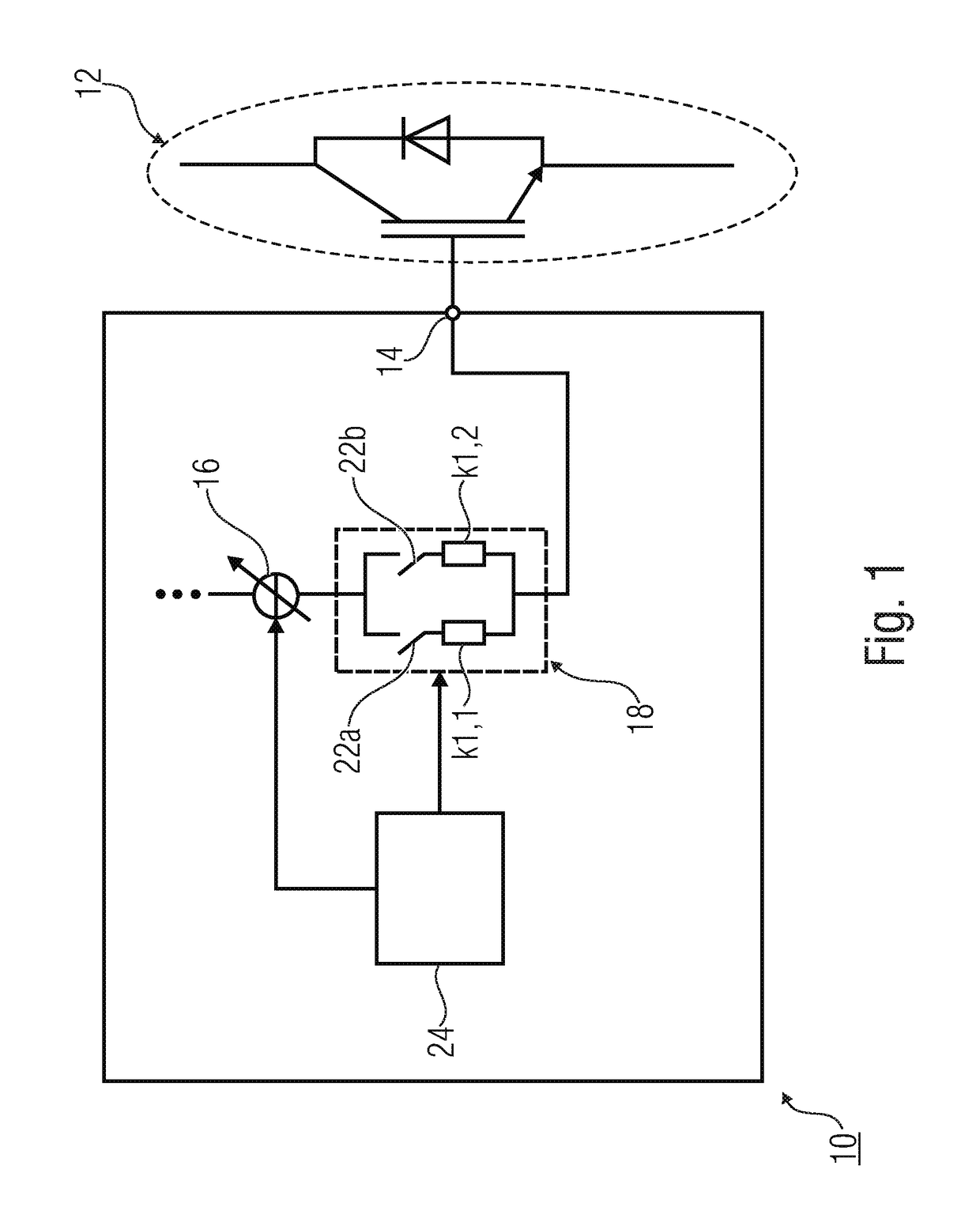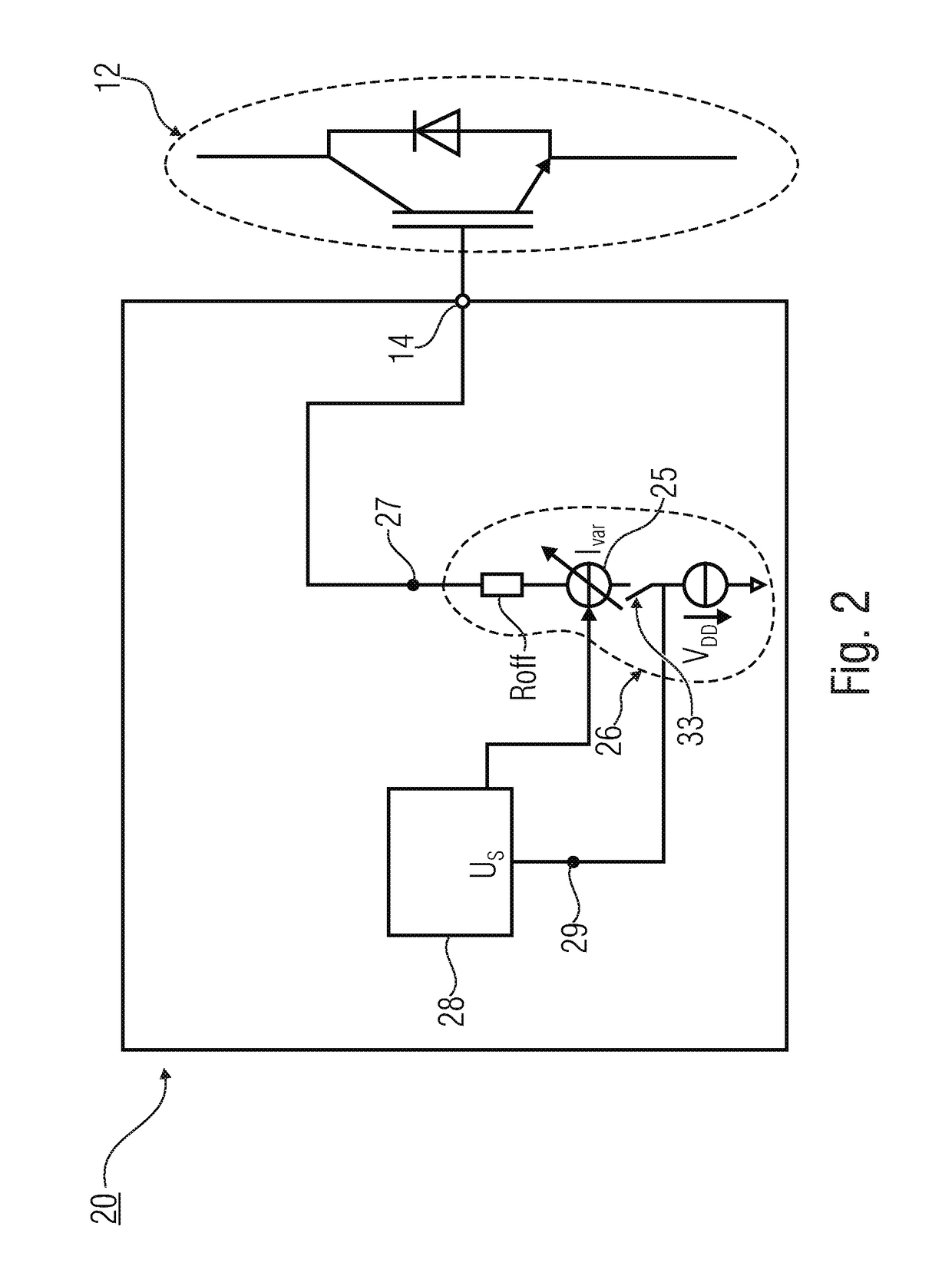Further, a tradeoff has to be found between short death /
delay time and di / dt behavior, du / dt behavior as well as power losses in the
tail phase.
Further, it is disadvantageous that the switching sequence does not compensate any component leakages, that high effort is necessitated when using new or different power switches for changing the topology or for adapting the switching behavior by component changes, that no flexible
adaptation or
scalability is given as well as no high or no configurable degree of protection is possible.
Interference
radiation conforming to standard heavily influences the losses and is not suitable for a partial load at the switch 12.
Disadvantages of such an embodiment are an increased need for components, a more complex
sequence control as well as additional (galvanically isolated) control channels.
This results in increased costs.
Further, it is disadvantageous that switching losses can be optimized only for one
operating point (
voltage, load current, temperature), that the switching sequence does not compensate any component leakages, that high effort results when using new / different power switches, that no flexible
adaptation /
scalability of the circuit is possible, that no high or even configurable degree of protection can be obtained.
Further, interference
radiation conforming to standards can be obtained, which influences the switching losses to a lesser degree.
It is a
disadvantage that increased need for components, more complex
sequence control as well as additional (galvanically isolated) control channels result which result in increased costs.
Switching losses can only be optimized for one
operating point (voltage, load current, temperature).
Further, the switching sequence does not compensate any component leakages.
A high effort results when using new / different power switches, no flexible
adaptation /
scalability of the
system is possible, and no high or even configurable degree of protection can be obtained.
Implementing a second voltage level causes additional losses, depending on the realization.
The disadvantages of this concept are that a significantly increased need for components results, mostly expensive analog components having a
high bandwidth are necessitated, increased losses occur in the GDU by components having a
high bandwidth, that
feedback circuits cause additional losses due to intervention, that increased costs occur, that switching losses can only be optimized for one operating point (voltage, load current, temperature), that the switching sequence does not compensate any component leakages, that high effort results when using new / different power switches, that no flexible adaptation or scalability of the concept is possible, that merely a configurable but no high degree of protection can be obtained, that a
high voltage potential (collector) necessitates installation space on a driver area, since air and creeping distances have to be considered, that
high voltage components have great leakages, that no adaptation of the control plane is possible by interventions of the feedbacks, that the usage of the measured parasitic
leakage inductance of the power switch is no precisely specified characteristic of the power switch itself, that with small leakage inductances no direct
processing of the
signal is possible and that the direct intervention with feedback comprises a phase shift such that the intervention, depending on the impedances in the gate line, only has a limited or no effect in
fast switching processes and can result in undesirable oscillations.
The disadvantages of this concept are a significantly increased need for components due to two programmable instances, that mostly expensive analog components having a
high bandwidth are necessitated, that increased losses occur in the GDU due to two programmable instances, that increased costs can result when using high-performance DSP and / or FPGA, that no optimization of the actual switching edge curve is necessitatedpreferential direction / possible, that switching losses can only be optimized for one operating point (voltage, load current, temperature), that the switching sequence does not compensate any component leakages, that a high effort results when using new / different power switches, that no flexible adaptation / scalability is possible and that merely a configurable but no high degree of protection can be obtained.
However, it is a
disadvantage of this concept that a significantly increased need for components results by a total of 14 switching paths, wherein also significantly increased costs result by 14 switching paths.
The concept has poor efficiency as never all paths are used at any time.
Further, great
space requirements result due to a plurality of control paths and feedback paths.
The usage of the parasitic
leakage inductance of the power switch is no specifically specified characteristic of the power switch resulting in measurement inaccuracies.
The usage of high-performance DSP and FPGA results in increased costs when implementing the concept.
Further, the switching sequence does not compensate any component leakage.
In summary, the main problem of all controlled methods, independent of whether the same are analog or digital is the lack of adaptation to the operating point of the
power unit.
Some component leakages and parameter variances of the power switches cannot be compensated.
All analog-controlled methods have the problem, as long as they have direct influence on the current switching edge, that they necessitate very expensive energy-hungry components having a high bandwidth resulting in a low energy efficiency.
Thus, additional control losses are generated.
The same are mostly expensive and frequently too inaccurate for
signal processing since the same are not operated in the optimum operating point.
Apart from that, looping-in this potential results in a large unused installation area due to the necessitated voltage clearances.
The problem of known digitally controlled solutions is also the lack of independent adaptation to the current operating point or the component leakage.
Unused paths represent unused areas and still cause component costs since the same are populated.
 Login to View More
Login to View More  Login to View More
Login to View More 


